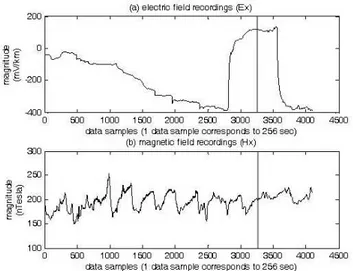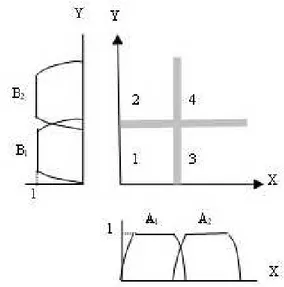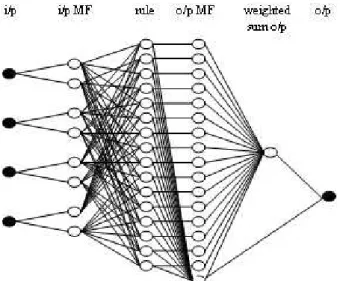Received: 10 July 2007 – Revised: 29 October 2007 – Accepted: 29 October 2007 – Published: 22 November 2007
Abstract. The study of the Earth’s electromagnetic fields prior to the occurrence of strong seismic events has repeat-edly revealed cases were transient anomalies, often deemed as possible earthquake precursors, were observed on electro-magnetic field recordings of surface, atmosphere and near space carried out measurements. In an attempt to under-stand the nature of such signals several models have been proposed based upon the exhibited characteristics of the ob-served anomalies and different possible generation mecha-nisms, with electric earthquake precursors (EEP) appearing to be the main candidates for short-term earthquake precur-sors. This paper discusses the detection of a ULF elec-tric field transient anomaly and its identification as a possi-ble electric earthquake precursor accompanying the Kythira
M=6.9 earthquake occurred on the 8 January 2006.
1 Introduction
This research work investigates signal characteristics related to the nature of the great ULF electrical transient anomaly and its possible identification as an electric earthquake pre-cursor (EEP) accompanying theM=6.9 Kythira earthquake occurred on the 8 January 2006 in the inner part of the Southern Hellenic arc, with epicenter coordinates N 36.21◦, E 23.41◦ and a focal-depth of 69 km. The ULF transient electrical anomaly was recorded by the Technological Ed-ucational Institute of Crete MVC-2DS recording station lo-cated at N 35.44◦, E 24.05◦, at a distance of 103 km from the epicentre of the main earthquake bearing N 34 W.
The MVC-2DS recording station was designed and de-veloped by the Institute of Terrestrial Magnetism, Iono-sphere and Radio-wave Propagation, Saint Petersburg Fil-ial (SPbF IZMIRAN), Russian Academy of Sciences, under Correspondence to:A. Konstantaras
(akonstantaras@chania.teicrete.gr)
the INTAS-99-1102 project titled “Study of the ULF elec-tromagnetic phenomena related to earthquakes (SUPRE)”. The MVC-2DS recording station (Hattori et al., 2004) has the capacity to measure three electric (telluric) components (dynamic range ±2.5 V) and uses a torsion photoelectric magnetometer (frequency range∼15 Hz, measurement range
±5000 nT). The sampling frequency is 50 Hz. The magnetic sensor is installed in the ground at 0.5 m depth and is covered with a plastic waterproof box. A 24 bit ADC unit is set up in a protective box in the vicinity of the magnetic sensor. Pb-PbCl2electrodes are buried in the ground at 1m depth for tel-luric measurements forming an orthogonal couple of 100 m short dipoles deployed in the directions NS and EW, respec-tively. The ADC gets time stamp from a connected to it GPS and the collected data are recorded via an RS-485 connection by the acquisition PC located in a shelter approximately 80 m away. The station has been operating since 2001.
Fig. 1. (a)The position of the asterisks indicate the magnitude (Ms) and time of occurrence of the main earthquake and the following aftershocks.(b)The observed transient electric anomaly in parallel with the seismic sequence.
Fig. 2. (a)Recorded electric field signal (Ex – bearing N-S) from approximately 9 p.m. on the 29 December 2005 till 1 p.m. on the 11 January 2006.(b)Simultaneous magnetic field recordings (Hx – bearing N-S). The vertical line indicates the time of the occurrence of the KythiraM=6.9 earthquake at approximately 11:35 a.m. on the 8 January, 2006.
The observed characteristics of the recorded possible elec-tric earthquake precursor support previous results (Konstan-taras et al., 2002, 2004, 2006a, b; Varotsos, 2005) regard-ing the features of EEP signals (Lighthill, 1996; Vallianatos and Tzanis, 1998; Tzanis and Vallianatos, 2001; Varotsos, 2005). It is well accepted that EEP signals are transient elec-tric potential anomalies external to the natural electromag-netic field of the Earth (Hayakawa and Molchanov, 2002; Vallianatos and Tzanis, 1998; Konstantaras et al., 2002). To enhance and strengthen the detection and identification
Fig. 3. (a)Recorded electric field signal (Ey – bearing E-W) from approximately 9 p.m. on the 29 December, 2005 till 1 p.m. on the 11 January, 2006.(b)Simultaneous magnetic field recordings (Hy – bearing E-W). The vertical line indicates the time of the occurrence of the KythiraM=6.9 earthquake at approximately 11:35 a.m. on the 8 January, 2006.
of the observed transient electric field anomaly as an EEP signal associated with the Kythira EQ, the authors have em-ployed a pattern recognition application with the incorpora-tion of neuro-fuzzy technology. A neuro-fuzzy model has been trained to predict (Konstantaras et al., 2006a, b) the recorded electric field signal during time-periods of minimal seismic activity. Following successful training, the activation of the neuro-fuzzy model upon the electric field recordings around the time of the Kythira earthquake resulted in the re-jection of the observed EEP signal from the surface electric field recordings. The neuro-fuzzy model has “decided” that the observed variation is not part of the natural electric field of the Earth due to ionospheric variability, thereby consider-ably suppressing the variation at its output.
2 Possible EEP signals extrinsic to the natural electric field of the Earth
the occurrence of the possible electric earthquake precursor. Then, propagating through the electric field recordings, the neuro-fuzzy model is used to forecast the next sample of the recorded signal based upon a number of previously recorded data. The purpose of the experiment is to identify whether the neuro-fuzzy model follows the detected EEP signal as if it was a part of the natural due to ionospheric variability electric field; or rejects it as an external distortion by consid-erably suppressing the EEP aiming for the actual value of the natural due to ionospheric variability electric field alone. The Ex component of the recorded electric field signal has been selected for training the neuro-fuzzy model because of the clear distinction between the ULF electric transient anomaly and the electric field background.
To train and evaluate the reaction of the neuro-fuzzy model, 4096 data samples of electric field recordings (Fig. 2a) have been selected (Konstantaras et al., 2004), corresponding approximately to the time-period starting at 9 p.m. on the 29 December 2005 and ending at 1 p.m. on 11 January 2006, which include the possible electric earth-quake precursor. Although the sampling frequency of the recorded data isfs=1 Hz, the overall data set has been dec-imated by a factor of 256 and filtered by a Chebyshev low-pass filter to prevent aliasing, for it is very costly in process-ing time (Kosko, 1991) to train a neural network with such a heavy workload. A sliding window consisting of four pre-vious inputs, atn−12,n−24,n−36 andn−48 (Addison and Wermter, 2002), propagating though the time-series deter-mines the input vectors to the neuro-fuzzy model. The first half of the input vectors, i.e. the first 2048 samples in the time-series, is used to train the neuro-fuzzy model to pre-dict the next sample (n+1) in the time-series (Jang et al., 1997), whilst the second half remains unseen. An initial neuro-fuzzy model is obtained by applying grid partitioning (Konstantaras et al., 2002) on the first half of the input data set. This initial model is subjected to training with a hybrid algorithm (Jang, 1993), a combination of the least squares method and the backpropagation algorithm. During a for-ward pass an input vector is fed to the neuro-fuzzy model and the least squares estimator is used to adapt its consequent
Fig. 4.Input space partitioning into four fuzzy regions correspond-ing to four fuzzy if-then rules. The number of inputs to the neuro-fuzzy model is four corresponding to an overall number of sixteen fuzzy if-then rules guiding the model.
parameters, which define the rules and output membership functions (MFs) of the model. A training error is computed by subtracting the output of the neuro-fuzzy model, for the current set of parameters, from the required output (the actual value of the electric field signal atn+1). The training error is deployed during the backward pass through the neuro-fuzzy model by the backpropagation algorithm to adapt its premise parameters, which determine the shape and dimensions of the input MFs. After every training epoch the neuro-fuzzy model is tested with the first 500 samples of the unseen data (also recorded before the occurrence of the possible electric earth-quake precursor) to prevent overtraining (Jang et al., 1997). The final neuro-fuzzy model holds the parameters set that minimized the checking error.
3 Neuro-fuzzy model architecture and operation analy-sis
Fig. 5. Neuro-fuzzy models’ architecture. Black nodes: inputs to and output from the neuro-fuzzy model. White nodes: neurons. Dashed node: rules’ bias neuron.
line in Fig. 5) sets a weighting factor to each rule. The neuron in layer 5 defuzzifies the normalised weighted outputs of all rules to produce a crisp output (layer 6). The layer by layer operation of the developed neuro-fuzzy model is described as follows (Jang, 1993):
Layer 1: The present and three previous samples of the recorded signal (electric or magnetic) are used as inputs (A
toD)to the network introducing recursion.
Layer 2: Every node i in this layer is an adaptive node with a node function: O1,i=µAi(x), for i=1,2, or O1,i=µBi−2(y), for i=3,4, or O1,i=µCi−4(z), for i=5,6, or O1,i=µDi−6(k), for i=7,8, where x (or y, or z, or k) is the input to nodei andAi (or Bi, orCi, orDi)is the equivalent membership function. The type of MFs A, B,
C andD is that of the generalised bell function: µA(x)=
1/
1+
x−ci
ai
2b
, where{ai,bi,ci}are the premise param-eters of the network which determine the shape and size of the MF.
Layer 3: Every node in this layer is a fixed node calculating the normalised firing strength of either rule:
O2,i=wi=Pwi
i
wi, wherewi=µAi(x)µBi(y)µCi(z)µDi(k).
Layer 4: Every nodeiin this layer is an adaptive node us-ing an output membership functions to compute the weighed output of the equivalent rule, according to the following node function:O3,i=wifiandfi=pi+qi+mi+ni+ri, where{pi, qi,mi,ni,ri}are the consequent parameters of the network that specify the rules of the fuzzy inference system.
Layer 5: The single node in this layer is a fixed node, which converts the weighted fuzzy outputs of all rules in the
Fig. 6. (a)Recorded electric field signal – the vertical line indicates the time of the occurrence of the KythiraM=6.9 earthquake at ap-proximately 11:35 a.m. on the 8 January, 2006; (b)Neuro-fuzzy model output indicating rejection of the possible EEP signal as an external addition upon the electric field recordings;(c)Error signal – the difference between the recorded electric field signal the output signal from the neuro-fuzzy model.
system into a single crisp output, as described by the follow-ing node function:O4,1=P
i wifi.
Layer 6: The node describes the actual output of the neuro-fuzzy model for a given input data set.
4 Pattern recognition results
The proposed neuro-fuzzy model was initially trained upon the first 2548 data-samples, of recorded electric field signal shown in Fig. 2a aiming to identify the main characteristics of the electric field variations and thus predict the next sam-ple in the time-series. The initial 2048 data samsam-ples were used for training the neuro-fuzzy model whilst the last 500 unseen to the network data samples (2049 to 2548) were used to monitor its performance and prevent overtraining the model.
data-samples 3530 and 3585. What is remarkable in this case is that once the model becomes stable again, which is almost immediately after the end of the duration of the EEP sig-nal around data sample 3595, the neuro-fuzzy model follows closely once more the recorded electric field signal.
The fact that the neuro-fuzzy model follows closely the recorded electric field signal before (signal to difference ratio of 30.46 dB) and after (signal to difference ratio of 28.40 dB) the occurrence of the EEP signal, and the rejection of the latter (signal to difference ratio of−39.69 dB) at the time of its occurrence (Fig. 6c) makes us believe that the neuro-fuzzy model treats the EEP signal as an external distortion added upon the natural due to ionospheric variability electric field of the Earth.
5 Conclusions
The possible electric earthquake precursor accompanying the Kythira M=6.9 earthquake was detected upon the electric field recordings of the electromagnetic field recording station in Keramia, Crete, but with no indication of the latter upon simultaneous magnetic field measurements. The outcome of the neuro-fuzzy pattern recognition experiment, suggests that this particular EEP-candidate signal is an extrinsic transient electric potential anomaly of a different source to the natural and of ionospheric origin electric field of the Earth. The er-ror signal highlights the close proximity of the neuro-fuzzy model’s output signal to the recorded electric field before and after the occurrence of the possible recorded EEP signal as well as the continuous incremental rejection of the latter at the time of its occurrence. The neuro-fuzzy model was also successful in estimating the boundaries of the observed tran-sient electric potential anomaly which are in accordance with the observed data. The duration of the possible EEP signal, outlasts other detected EEP candidate signals, lasting for a couple of days rather than a couple of hours. Furthermore, the possible EEP signal attributed to the Kythira earthquake precedes but also super-cedes the main seismic event which occurred at 11:34 GMT on the 8 January, 2006. The rising
Fund (75%) and national resources (25%).
Edited by: P. F. Biagi
Reviewed by: two anonymous referees
References
Addison, J. F. D. and Wermter, S.: Methods for investigating mem-ory into neural networks applied to condition monitoring, Proc. of the Int. Conf. on A.I. and Soft Computing, Banff, Alberta, Canada, 380–384, 2002.
Freund, F. T.: Pre-earthquake signals – Part I: Deviatoric stresses turn rocks into a source of electric currents, Nat. Hazards Earth Syst. Sci., 7, 535–541, 2007,
http://www.nat-hazards-earth-syst-sci.net/7/535/2007/.
Hattori, K.: ULF geomagnetic field measurements in Japan and some recent results associated with Iwateken Nairiku Hokubu earthquake in 1998, Phys. Chem. Earth, 29, 481–494, 2004. Hayakawa, M. and Molchanov, O. A.: Seismo
Electromag-netics Lithosphere-Atmosphere-Ionosphere Coupling, TERRA-PUB, Tokyo, 335–343, 2002.
Haykin, S.: Neural networks: a comprehensive foundation, Macmillan College Publishing, 135–155, 1994.
Hollerman, W.: Electric currents in granite and gabbro generated by impacts up to 1 km/sec, AGU Fall Meeting, San Francisco, T31A-0419, 2006.
Jang, J.: ANFIS: Adaptive Network-based Fuzzy Inference Sys-tems, IEEE Transactions on SysSys-tems, Man, and Cybernetics, 23(3), 665–685, 1993.
Jang, J., Sun, T., and Mizutany, E.: Neuro-fuzzy and soft comput-ing, Prentice Hall, 335–363, 1997.
Konstantaras, A., Varley, M. R., Vallianatos, F., Collins, G., and Holifield, P.: Recognition of electric earthquake precursors using neuro-fuzzy methods: methodology and simulation results, Proc. IASTED Int. Conf. Signal Processing, Pattern Recognition and Applications (SPPRA 2002), Crete, Greece, 303–308, 2002. Konstantaras, A., Varley, M. R., Vallianatos, F., Collins, G., and
Holifield, P.: A neuro-fuzzy approach to the reliable recognition of electric earthquake precursors, Nat. Hazards Earth Syst. Sci., 4, 641–646, 2004,
http://www.nat-hazards-earth-syst-sci.net/4/641/2004/.
applied to severely distorted magnetic field recordings, IEEE Geosci. Remote S., 3(4), 161–165, 2006a.
Konstantaras, A., Varley, M. R., Vallianatos, F., Collins, G., and Holifield, P.: Neuro-fuzzy technology for the detection of weak seismo-electric signals, Proc. of the Atlantic Europe Conference in Remote Imaging and Spectroscopy (AECRIS), Preston, UK, 151–157, 2006b.
Kosko, B.: Neural networks for signals processing, Prentice Hall, Upper Saddle River, NJ, 399 pp., 1991.
Lighthill, J.: A critical review of VAN, World Scientific, Singapore, 29–76, 1996.
Teisseyre, R. (Ed.): Theory of Earthquake premonitory and fracture processes, Polish Scientific Publishers, 520–528, 1995. Teisseyre, R. and Nagahama, H.: Dislocational models of electric
field generation in a seismic source zone, in: Atmospheric and Ionospheric Electromagnetic Phenomena Associated with Earth-quakes, edited by: Hayakawa M., Terra Scientific Publishing, Tokyo, 271–285, 1999.
Tzanis, A. and Vallianatos, F.: A critical review of Electric Earth-quake Precursors, Annali di Geofisica, 44(2), 429–460, 2001. Tzanis, A. and Vallianatos, F.: A physical model of
elec-tric earthquake precursors due to crack propagation and the motion of charged edge dislocations, in: Seismo-Electromagnetics: Lithosphere-Atmosphere-Ionosphere Cou-pling, edited by: Hayakawa, M. and Molchanov, O. A., Terra Sci. Pub. Co., Tokyo, 117–130, 2002.
Vallianatos, F. and Tzanis A.: Electric current generation associated with the deformation rate of a solid: Preseismic and coseismic signals, Phys. Chem. Earth, 23, 933–938, 1998.


